Guide to the names on a Chinese DVD
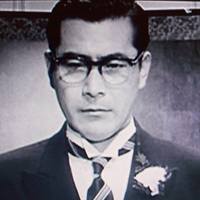 Toshiro Mifune as Nishi/Sai
Toshiro Mifune as Nishi/Sai
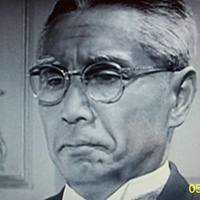
Masayuki Mori as Iwabuchi/Aim
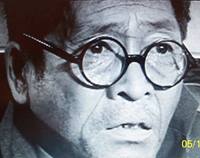
Kamatari Fujiwara as Wada/Woo
Trying to make sense of the broken English subtitles (“It’s not to say it so firmly.”) in the cheap Chinese copy of Kurosawa’s great film is hard enough, but what they did to the names is just baffling. Three of the main characters are Iwabuchi, Nishi, and Moriyama. Rather than simply supply those names in the subtitles, they are called Aim, Sai, and South. That last one is especially annoying. Does Moriyama mean ‘South’ in Japanese? I don’t know, but generally they use short, one syllable Chinese names for the Japanese names, but occasionally throw in an inexplicable English word.
The IMDB article is a useful reference for this film, and the actual names of the characters and actors. Also, if you want it on DVD, The Bad Sleep Well – Criterion Collection is excellent, notably including fluent accurate English subtitles, and using the original Japanese names of the characters.
The movie itself, loosely based on Hamlet, deals with a young man (Nishi) who marries the daughter of the corporate executive (Iwabuchi) who was responsible for his father’s suicide. Set in contemporary Japan, it uses a backdrop of corporate corruption. The plot and the motivations unroll gradually as the film develops, and to detail too much would be a spoiler, with little purpose. The Bad Sleep Well was filmed in Tohoscope, a 2.35:1 aspect ratio, as were all of Kurosawa’s films in the early Sixties. Of course, you want to watch the DVD in that format.
Table of Character Names
This should help anyone watching the annoying, cheap DVD that I bought on eBay (part of a 33-DVD set, for which I paid $60. I say they were worth just about two dollars apiece!)
| CHARACTER | DESCRIPTION | ACTOR | NAME ON DVD | |
| Koichi Nishi | son-in-law of Iwabuchi | Toshiro Mifune | Sai | |
| Iwabuchi | Dairyu Corporation Vice President | Masayuki Mori | Aim | |
| Keiko Nishi | dau. of Iwabuchi | Kyoko Kagawa | Kai | |
| Tatsuo Iwabuchi | son of Iwabuchi | Tatsuya Mihashi | Sun | |
| Administrative Officer Moriyama | Dairyu officer | Takashi Shimura | South | |
| Contract Officer Shirai | Dairyu officer | Ko Nishimura | Pak | |
| Itakura | Nishi’s friend | Takeshi Kato | Pan | |
| Assistant-to-the-Chief Wada | Dairyu officer | Kamatari Fujiwara | Woo | |
| n.a. | Nishi’s father who committed suicide | not on screen | Koo | |
| n.a. | Dairyu Corp | n.a. | Tai Lung |
There are more characters, given names in the English subtitles like Sam, Poo, Cheung, and Yau, but the ones above are the main ones.
And now .. a few comments on the movie itself.
Who Sent the Second Cake?
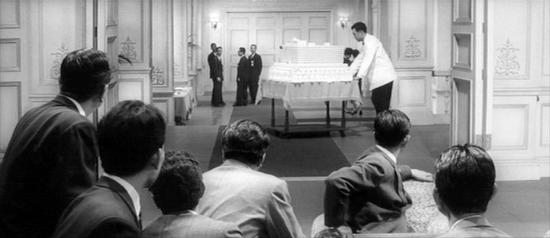
One of the most remarkable scenes takes place at the wedding, when the master of ceremonies announces the cutting of the cake; you can hear him use the English words “wedding cake.” Mendelssohn’s ‘Wedding March’ plays loudly. Waiters bring in a round 3-level wedding cake from the side. Just then, another cake is wheeled in from the front of the hall (see photo above). Oddly, the cake looks exactly like a rectangular office building, with a dark rose sticking out of one of the upper windows. It’s a massive, perfectly-prepared cake, but decidedly odd for a wedding cake. The gathered reporters fill us in, “Look, another cake. … Who sent it? … The rose is in the window of the suicide.”
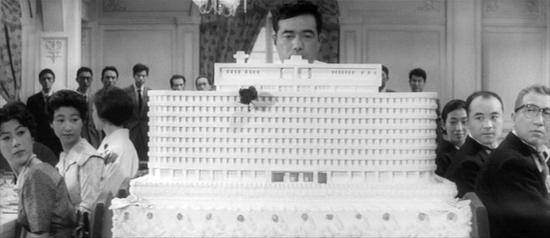
As the March blares away grandly, the cake swings close to the camera, and we get a good look at the rose in the seventh story window. The waiter rolls the cake down the center aisle; it comes right at us, and we get another close-up of the rose; the shot demonstrating Kurosawa’s effective use of the wide-screen format. The executives, recognizing the building (their own corporate headquarters and the location of the suicide) gasp in shock. The MC drops the cake knife.
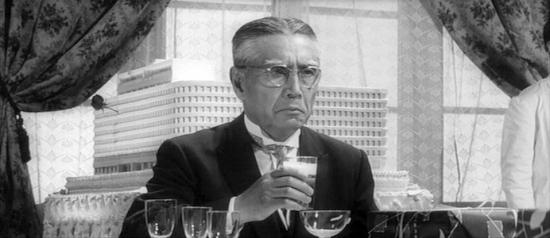
When the cake swings by the main wedding table, Iwabuchi nods slightly to another executive, as if to say, “Let it ride. Pay no attention.” The waiter leaves the cake right behind Iwaguchi, and the eyes of everyone in the room are on him. Impassively, he sips his waiter, and nods to a flunky, who orders the hapless MC to continue.
Fantastic. It is a scene to rival the opening of The Producers, the Mos Eiseley cantina in Star Wars, or Major Kong riding the bomb in Dr. Strangelove.
Watching His Own Funeral
Nishi persuades Wada (aka “Woo”) to fake his own suicide, as part of his plan to strike back at the corrupt executives who caused his own father to take his life. From Nishi’s car, Wada/Woo, in rapt fascination, watches his own funeral. Wada/Woo is played is played by Kamatari Fujiwara, one of my favorites among Kurosawa’s supporting actors, an actor who portrayed many widely varying characters, and brought a certain nervous, but sympathethic, energy to all of them.
Listen carefully to the dialog; you can hear the words “tape recorder,” which had been assimilated into Japanese.
Money, What Money?
Shirai, “Pak,” one of the corporate flunkies, is told to fetch the kickback money from the safe deposit box. He’s shocked to discover it’s missing, since only he and the now-assumed “dead man” Wada had access. He explains to Iwabuchi and Moriyama, who are skeptical. He’s told to bring his briefcase into the office, but Nishi has slipped the allegedly missing money into the briefcase. Shirai’s panic is so effective, it overwhelms the potential comedy of the scene.

When Shirai goes to the bank, he steps out of a 1958 Dodge Regal, reflecting a time when big American sedans were the status cars of the Japanese corporate class.
Wide-screen images courtesy of Kurosawamovies.com